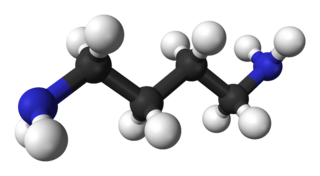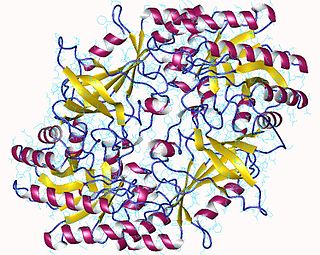
Putrescine is an organic compound with the formula (CH2)4(NH2)2. It is a colorless solid that melts near room temperature. It is classified as a diamine. Together with cadaverine, it is largely responsible for the foul odor of putrefying flesh, but also contributes to other unpleasant odors.

The enzyme ornithine decarboxylase catalyzes the decarboxylation of ornithine to form putrescine. This reaction is the committed step in polyamine synthesis. In humans, this protein has 461 amino acids and forms a homodimer.
Spermine is a polyamine involved in cellular metabolism that is found in all eukaryotic cells. The precursor for synthesis of spermine is the amino acid ornithine. It is an essential growth factor in some bacteria as well. It is found as a polycation at physiological pH. Spermine is associated with nucleic acids and is thought to stabilize helical structure, particularly in viruses. It functions as an intracellular free radical scavenger to protect DNA from free radical attack. Spermine is the chemical primarily responsible for the characteristic odor of semen.

Spermidine is a polyamine compound found in ribosomes and living tissues and having various metabolic functions within organisms. It was originally isolated from semen.

Spermidine synthase is an enzyme that catalyzes the transfer of the propylamine group from S-adenosylmethioninamine to putrescine in the biosynthesis of spermidine. The systematic name is S-adenosyl 3-(methylthio)propylamine:putrescine 3-aminopropyltransferase and it belongs to the group of aminopropyl transferases. It does not need any cofactors. Most spermidine synthases exist in solution as dimers.
Spermine synthase is an enzyme that converts spermidine into spermine. This enzyme catalyses the following chemical reaction
A polyamine oxidase (PAO) is an enzymatic flavoprotein that oxidizes a carbon-nitrogen bond in a secondary amino group of a polyamine donor, using molecular oxygen as an acceptor. The generalized PAO reaction converts three substrates into three products. Different PAOs with varying substrate specificities exist in different organisms. Phylogenetic analyses suggest that PAOs likely evolved once in eukaryotes and diversified by divergent evolution and gene duplication events, though some prokaryotes have acquired PAOs through horizontal gene transfer.

Flavin-containing amine oxidoreductases are a family of various amine oxidases, including maize polyamine oxidase (PAO), L-amino acid oxidases (LAO) and various flavin containing monoamine oxidases (MAO). The aligned region includes the flavin binding site of these enzymes. In vertebrates, MAO plays an important role in regulating the intracellular levels of amines via their oxidation; these include various neurotransmitters, neurotoxins and trace amines. In lower eukaryotes such as aspergillus and in bacteria the main role of amine oxidases is to provide a source of ammonium. PAOs in plants, bacteria and protozoa oxidise spermidine and spermine to an aminobutyral, diaminopropane and hydrogen peroxide and are involved in the catabolism of polyamines. Other members of this family include tryptophan 2-monooxygenase, putrescine oxidase, corticosteroid-binding proteins, and antibacterial glycoproteins.

Diamine acetyltransferase 1 is an enzyme that in humans is encoded by the SAT1 gene found on the X chromosome.

Polyamine-modulated factor 1 is a protein that in humans is encoded by the PMF1 gene.

Spermine oxidase is an enzyme that in humans is encoded by the SMOX gene.

COP9 signalosome complex subunit 7b is a protein that in humans is encoded by the COPS7B gene.

Peroxisomal N(1)-acetyl-spermine/spermidine oxidase is an enzyme that in humans is encoded by the PAOX gene.

Diamine acetyltransferase 2 is an enzyme that in humans is encoded by the SAT2 gene. SAT2 maintains a key metabolic glutamine/glutamate balance underpinning retrograde signaling by dendritic release of the neurotransmitter glutamate.
A polyamine is an organic compound having more than two amino groups. Alkyl polyamines occur naturally, but some are synthetic. Alkylpolyamines are colorless, hygroscopic, and water soluble. Near neutral pH, they exist as the ammonium derivatives. Most aromatic polyamines are crystalline solids at room temperature.
N1-acetylpolyamine oxidase (EC 1.5.3.13, hPAO-1, mPAO, hPAO) is an enzyme with systematic name N1-acetylpolyamine:oxygen oxidoreductase (3-acetamidopropanal-forming). This enzyme catalyses the following chemical reaction
Polyamine oxidase (propane-1,3-diamine-forming) (EC 1.5.3.14, MPAO, maize PAO) is an enzyme with systematic name spermidine:oxygen oxidoreductase (propane-1,3-diamine-forming). This enzyme catalyses the following chemical reaction
Non-specific polyamine oxidase (EC 1.5.3.17, polyamine oxidase, Fms1, AtPAO3) is an enzyme with systematic name polyamine:oxygen oxidoreductase (3-aminopropanal or 3-acetamidopropanal-forming). This enzyme catalyses the following chemical reaction
Homospermidine synthase (EC 2.5.1.44) is an enzyme with systematic name putrescine:putrescine 4-aminobutyltransferase (ammonia-forming). This enzyme catalyses the following chemical reaction
BpsA is a single-module non-ribosomal peptide synthase (NRPS) located in the cytoplasm responsible for the process of creating branched-chain polyamines, and producing spermidine and spermine. It has a singular ligand in its structure involved with Fe3+ and PLIP interactions. As seen by its EC number, it is a transferase (2) that transfers an alkyl or aryl group other than methyl groups (5) (2.5.1). BpsA was first discovered in the archaea Methanococcus jannaschii and thermophile Thermococcus kodakarensis and since then has been used in a variety of applications such as being used as a reporter, researching phosphopantetheinyl transferase (PPTase), and for NRPS domain recombination experiments it can be used as a model. Both (hyper)thermophilic bacteria and euryarchaeotal archaea seem to conserve BpsA and orthologs as branches chains polyamines are crucial for survival. There is also a second type of BpsA also known as Blue-pigment indigoidine synthetase that produces the pigment indigoidine and is found in organisms like Erwinia chrysanthemi. However, not much seems to be known about this variant except that it is a synthase, and it does not yet appear to be classified under an EC number.











